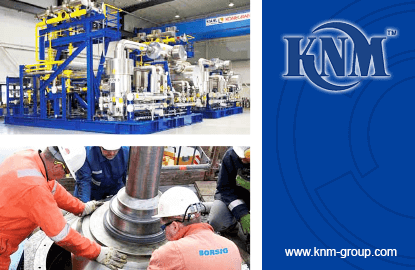
PREVIOUS attempts by KNM Group Bhd to take the company up a notch have not borne much fruit, casting a shadow on investors’ confidence in its renewable energy (RE) ventures. This is despite the RE sector being seen as a sunrise industry.
In a bid to boost earnings, the oil and gas equipment company announced a process equipment venture in Brazil and waste-to-energy projects in Sri Lanka in 2008 and 2011 respectively. However, both failed to deliver and KNM exited Brazil in 2013 while the Sri Lankan projects have been put on hold.
Nevertheless, KNM’s founder and CEO Lee Swee Eng believes that the next five years will be a key transition period for the group, as it may see recurring income from RE jump to 70% of its total revenue and earnings.
According to Lee, oil and gas (O&G), which is KNM’s core business now, will become its secondary business.
Based on his initial estimates, KNM’s Thai ethanol plant should start contributing recurring income of RM15 million in the financial year ending Dec 31, 2017 (FY2017), rising to RM35 million annually by FY2018 once capacity doubles to 400,000 litres that year.
In addition, the first phase of its Peterborough waste-to-energy project is expected to kick-start in FY2018, raising its annual recurring income by another RM50 million. The first phase of the UK project has a capacity of 18mw while the plant’s total capacity is 80mw.
Lee says recurring income will account for 15% of KNM’s total revenue and earnings in FY2017, climbing to 35% in FY2018. Currently, there is minimal contribution in the form of recurring income from the RE segment while contract income from engineering, procurement, construction and commissioning (EPCC) jobs from the same segment comes in at about 5%.
Other than the recurring income from its 72%-owned Thai ethanol project and 80%-owned Peterborough project in the next two financial years, KNM is also in talks with a potential partner in the US to undertake advanced pyrolysis technology (APT) to convert waste tyres into energy.
And KNM expects its Canada oil sands project to turn around by FY2017 via waste energy projects.
“We are the only Malaysian company with APT and the American company has chosen us to explore three projects in North America. We will enjoy recurring income of 30% from these projects without having to fork out extra capital,” Lee says. He is hopeful the plan will be realised this year.
However, fund managers remain sceptical over KNM’s prospects, given the group’s poor track record. A fund manager from a foreign asset management house tells The Edge he will only invest when KNM delivers on its many projects.
“It has disappointed us many times,” he says, adding that the UK’s exit from the European Union (Brexit) is also a concern for the Peterborough project. Indeed, it is not a new venture. It dates back to December 2010, when KNM secured the EPCC job for the plant, but it encountered delays due to financing issues.
Another veteran fund manager, who also shies away from KNM, says the company has lost focus.
“It is an O&G engineering company but renewable energy is utility, which is different from its usual business. Management should focus on improving its O&G earnings, rather than expanding into energy projects so far away. KNM should convince us with the figures as its PER [price-earnings ratio] is still relatively high,” the fund manager says.
KNM’s net profit fell 69% to RM10.79 million in the first quarter from RM35.05 million a year ago, partly dragged down by its oil sand business in Canada. According to Bloomberg data, at its closing price of 40.5 sen last Friday, KNM trades at forward and historical PER of 9.8 and 30.92 times respectively.
KNM entered Brazil in 2008 to enhance its process equipment business for O&G but it ended up exiting Brazil in 2013 to cut its losses on the venture. In 2012, KNM’s waste-to-energy projects in Sri Lanka, awarded by Octagon Consolidated Bhd, also faced problems as the latter underwent a restructuring.
KNM’s frequent cash calls are another reason it is not an investor favourite now, unlike in 2008. In the last two financial years, the group undertook two right issues and two private placements, raising total proceeds of RM522.78 million.
However, KNM’s Lee disagrees with the fund managers, saying it faced external risks that were beyond its control, namely the 2008 global financial crisis. “When you are fighting fire, it is not always that you can deliver exactly what you have promised. That is why there were some disappointments. We went to the banks ... to refinance our debts, but the banks refused. It was beyond our control.”
He says the group ventured into other sectors as O&G is a cyclical business. As such, he hopes to widen the group’s income by creating a recurring income stream for its long-term sustainability.
He foresees no further delays of the Peterborough project and says KNM should benefit from Brexit as the lower pound sterling makes the construction more affordable. Moreover, Export-Import Bank of Malaysia recently approved a loan of £35 million (about RM187 million) for KNM.
KNM’s gearing ratio stood at 0.27 times as at end-December last year. Lee expects the group’s gearing ratio to remain below 0.5 times this year.
The group’s order book stands at RM5.2 billion, including the in-house jobs from Peterbourough and Pengerang, Johor.. which will keep it busy for the next three years. It is actively tendering for jobs worth up to RM10 billion, with half being renewable energy projects. The group’s average success rate is about 30%.
Save by subscribing to us for your print and/or digital copy.
P/S: The Edge is also available on Apple's AppStore and Androids' Google Play.